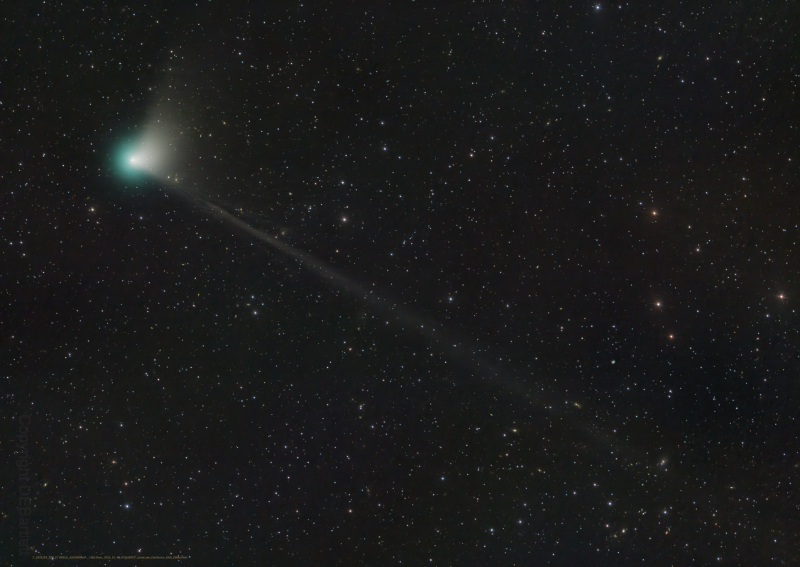| An Icy Visitor in early 2023: Comet C/2022 E3 (ZTF) (2023-1-03) ⬅︎ |
 |
Our distant ancestors were often terrified when comets appeared. These days stargazers react with great excitement instead because every comet-encounter is unique. This is the case with C/2022 E3 (ZTF). After spending thousands of years in the distant reaches of our solar system, this comet will soon be coming near Earth. Will we be able to see it naked-eye? Will it have a long tail? Will it be colorful? We'll soon find out!
But first, why the funny name C/2022 E3 (ZTF)? It's all very technical....
| C | The comet is not periodic and will likely never come again. If it were periodic, like Halley's Comet, 'P' would be used instead. |
| 2022 | Year of discovery |
| E | It was found in the first half of March. A = 1st half of Jan. B = 2nd half of Jan. C = 1st half of Feb and so on. |
| 3 | It was the third found during this half-month. Yes, lots of comets are being found year-round but few come near us. |
| ZTF | Zwicky Transient Facility, the robotic telescope at Palomar Observatory that found it. This and others around the world search for comets and other moving objects every clear night. If a comet is found by a person, then that person's name becomes part of the comet's name. These days, it's pretty tough for people with small telescopes to compete with large robotic telescopes that are up all night, every night. |
Calculations show that this comet will swing around the Sun on January 12, 2023 and then come by Earth on February 1 at a distance of just 26 million miles. This is really close considering that the distance from Earth to the Sun is 91 million miles.
So what are comets exactly? They are ancient, rock-ice worlds that are left over from the formation of our solar system. They range in size from a few miles to tens of miles wide which is quite small compared to moons and planets. If you think of them as mountain-sized 'dirty snowballs' you'll have a pretty good understanding.
Most of the time comets reside in the distant reaches of our solar system. Sometimes their orbits cause them to travel to the inner solar system where things can get very interesting. When a comet comes close to us, the intense energy of the Sun can begin melting it and the incredibly strong solar wind can then blow the loosened particles into space forming tails which can be millions of miles long.
One thing to note about comet tails -- they always point away from the Sun. So, in the photo above, you can't tell which way the comet is moving but you call tell where the Sun is -- in the opposite direction of the tail.
What kind of show might C/2022 ED (ZTF) put on? We think it could become brighter than magnitude +6.00 which means that it would be visible to the naked-eye from a dark location. In any case, it will be visible in small binoculars and telescopes.
Path of Comet C/2022 ED (ZTF)
How to View
* Location in our sky: the video above shows the comet's location for Starry Hill from Jan 15 to Feb 28 at 9pm. It will be in our northern sky at first and will travel southward each day. It will pass Polaris on Jan 29 and Mars on Feb 9.
* When: it be at its brightest during the last week of January and the first week of February. Unfortunately, moonlight will be increasing during this time making viewing more difficult as time goes on.
C/2022 ED (ZTF) just may put on a spectacular show -- perhaps the best since Comet Neowise in 2020. Good luck to us all!
Photo Credit/Copyright: Dan Bartlett |
| |



